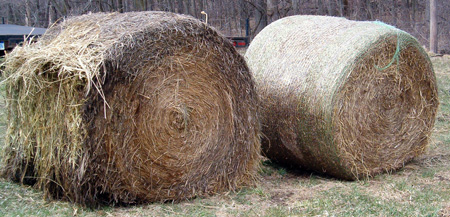Storing biomass in round bales
Studies show differences in dry matter losses from outside storage of biomass
Growing, harvesting and storing large amounts of biomass will be necessary to achieve mandates for cellulosic ethanol set in the Energy Independence and Security Act of 2007. According to the act, we will need to ramp up production of biofuels from biomass sources to 16 billion gallons by the year 2022. It will take approximately one billion tons of biomass to produce this level of biofuel.
Farmers and biorefineries will need to figure out the most economical way to store biomass with the least amount of loss. A recently published study by Kevin Shinners, University of Wisconsin-Madison, evaluated a number of harvest and storage components for switchgrass. In the study, a John Deere 567 round baler was used to create round bales that were wrapped with sisal twine, plastic twine and net wrap. Bales were then transported off the field to storage sites. There were five outside storage treatments and two undercover storage treatments (Table 1). Bales stored outside were placed on grass sod and spaced about a foot apart in rows with about six foot of space between rows of bales. The undercover treatments included inside a water-tight pole barn and wrapped or ensiled. Bales were left in their respective storage treatments from August 30 to June 19 (293 days).
Table 1. Storage location and treatments for large round bales of switchgrass with corresponding dry matter (DM) loss as a percent of the total.
| Storage Location and Treatment[a] | DM Loss (% of total) |
| Outdoor | |
| ST | 15.4 d |
| PT | 9.3 c |
| NW | 9.0 c |
| BF | 5.4 b |
| PF | 5.7 b |
| Under Cover | |
| IN | 4.9 b |
| WE | 2.0 a |
| LSD (p=0.05) | 2.6 |
[a] ST=sisal twine, PT=plastic twine,
NW=net wrap, BF=breathable film,
PF=plastic film, IN=indoors,
WE=wrapped plastic film tube and
ensiled.
Bales that were baled at higher moisture, wrapped and ensiled (WE) had the lowest DM loss during the storage period. Bales stored indoors (IN) were similar in DM loss to bales stored outdoors wrapped with plastic film (PF) and breathable film (BF) treatments. Net wrap (NW) and plastic twine (PT) had higher DM loss at about 9 percent. Sisal twine (ST) had the highest dry matter loss (over 15 percent), mostly due to the fact that it didn’t keep the outside of the bale tight enough to shed water and snow. There will likely be discounts for poor quality biomass, such as this outer layer.

Both switchgrass bales were stored outside from September to April. The bale on the left was wrapped with sisal twine while the bale on the right was net wrapped. The outer layer of the bale on the left has noticeably more wetness and spoilage.
While the ensiled bales had the lowest DM loss, it is important to note that high moisture, silage-type material will be more expensive to transport to a biorefinery due to the higher water content. Likely, if high moisture biomass is preferred by a biorefinery, storing it in a bunker silo will be more cost effective.
The second best option is to store bales indoors, which will require higher capital cost. If bales are to be stored outdoors, which is likely for the biomass supply chain, it is best to net wrap the bales as it can be done at harvest time and requires less time and equipment. The breathable film (BF) and plastic film (PF) had similar DM losses, but bale wrapping equipment will be needed.
So the bottom line is, if you are thinking about buying a round baler to harvest biomass for a biorefinery or for hay to feed livestock, the net wrap system will provide the best outside storage option. For those that have a round baler-switching from sisal twine to plastic twine will also save a significant amount of DM loss when storing bales outside. The cost per bale for twine and net wrap as well as differences in the equipment cost need to be considered.
Reference
Shinners, K. J., G. C. Boettcher, et al. (2010). "Harvest and storage of two perennial grasses as biomass feedstocks." Transactions of the Asabe 53(2): 359-370.



 Print
Print Email
Email


